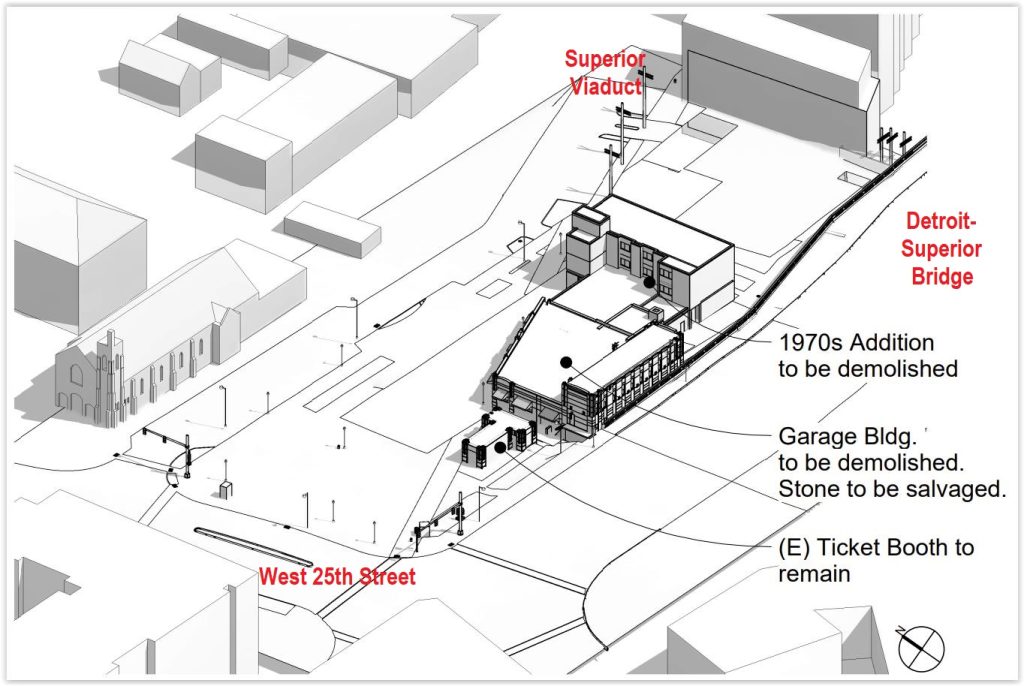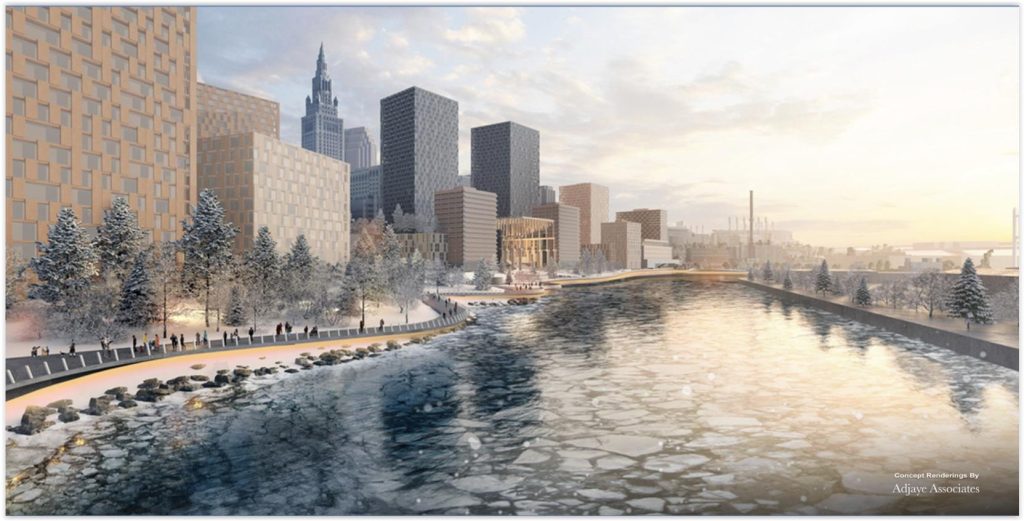Much of the rebuilding in Cleveland’s Midtown, between downtown and University Circle, has focused along the parallel east-west roadways of Euclid, Carnegie and Chester avenues. But the primary north-south axis, East 55th Street, is largely devoid of similar development activity. That’s true even where East 55th intersects Euclid, Carnegie and Chester.
Those intersections once had the density and activity of a small downtown called Penn Square, with large apartment and commercial buildings, shops, cafes, theaters, two streetcar lines that carried 150,000 riders per day (as many riders as all of the transit agencies combined serving Northeast Ohio today), and Cleveland’s main station for the Pennsylvania Railroad that had 24 daily passenger trains to/from places as far west as St. Louis and as far east as New York City.
Today, it is home to social service organizations, gas stations, vacant lots, abandoned buildings, and a City of Cleveland vehicle maintenance garage. That could soon change with two major developments emerging and long-range planning underway.
Indeed, it already is changing with more than $80 million in new development within a few blocks of the East 55th-Euclid/Carnegie/Chester area. This includes a new Link 59 office building, University Hospitals Rainbow Center for Women and Children, and Dave’s Supermarket just east of East 55th. Just west of East 55th, a 65,000-square-foot former automobile assembly building at 4600 Euclid Ave. was renovated into offices, as was the 54,000-square-foot former Agora Building (previously the Metropolitan Theater opera house and WHK auditorium) into the Offices at Penn Square, 5000 Euclid.
Two major, new developments are being pursued by proven companies with a good track record of delivering complicated and/or large-scale projects in Cleveland: Berusch Development Partners, LLC and Pennrose Properties, LLC.
Pennrose’s plans — to redevelop the long-vacant Warner & Swasey complex — are publicly available albeit still conceptual. They are posted at the Cleveland Opportunity Zone Exchange, a Web-based portal where investors seeking to minimize capital gains taxes and where real estate developers seeking to build within designed Opportunity Zones (dubbed O-zones) can find each other.
 |
| Warner & Swasey’s four lower-level sheds as seen from the roof of?the factory’s taller structures. This view is one of 15 photos of the site by Jeffrey R. Stroup published in an online slideshow by Scene Magazine (Scene). |
Pennrose estimates the Warner & Swasey redevelopment will cost about $53 million and is seeking a $10 million Opportunity Zone investment.
The City of Cleveland, which owned the Warner & Swasey property since 1991, requested proposals for the redevelopment of the unused, 3.1-acre site last year. The RFP also noted that if the winning developer wished to acquire the neighboring city-owned parcels, totaling 7.9 acres and which includes a city vehicle maintenance garage, the city would be willing to consider selling them as long as the developer has a strategy for replacing the garage.
Pennrose was the winner. According to its listing on the O-zone portal, the Philadelphia-based firm acquired the entire 7.9 acres of land, which includes the east side of East 55th, from Carnegie to Euclid and over to the Norfolk Southern Corp. railroad tracks. The city will contribute to the project several vacant, decaying buildings ranging from one to five stories tall and totaling 221,727 square feet, Pennrose representatives said in their listing.
 |
| A rendering of the Warner & Swasey property for a renovation project proposed in 2010. That project fell through (Geis). |
The north end of the site was the former?Pennsylvania Railroad passenger station?which was built in 1912 (replacing smaller depots dating to the 1850s) and demolished in 1973. Its two pedestrian underpasses below the tracks, which had stairwells and baggage elevators up to track-level platforms, remain. South of it is the five-story Warner & Swasey building, made of reddish-brown stone and constructed from 1904 to 1910. It replaced the original Warner & Swasey facility that had been erected on this site in the early 1880s. Warner & Swasey built telescopes and machine lathes here.
As currently proposed, the low-level structures will be repurposed to provide covered parking while the five-story building will offer housing over offices and a small amount of amenity retail to support the residential and office tenants. The housing will be affordable at a range of incomes and targeted to mixed-income workforce households. The office and program space will be marketed to supportive services for job readiness, workforce development and employment training organizations.
“We believe the site will be able to achieve collected rents within a comparable range of the overall rent per square foot averages at the selected properties (that offer comparable residences nearby),” Pennrose representatives said in a written statement.
Estimated monthly rents are $1,105 to $1,170 for one-bedroom units and $1,275 to $1,360 for two-bedroom units. These rents are well below the average collected rents at the comparable developments in the Midtown/University Circle area. Pennrose anticipates receiving Low Income Housing Tax Credits this year, as well as federal and state Historic Tax Credits, New Market Tax Credits plus private debt, most likely agency products with favorable terms.
Pennrose has a track record with large-scale, complicated and historic renovation projects in lower-income neighborhoods nationwide. Its best local example is the renovation and conversion of the 1927-built, 380,000-square-foot St. Luke’s Hospital in Cleveland’s Buckeye-Shaker neighborhood into a senior housing complex. The long-vacant building was heavily vandalized but Pennrose was able to bring it back to life as St. Luke’s Manor for $53 million — ironically for the same price as is estimated for the Warner & Swasey project.
Meanwhile, at the southwest corner of Euclid and East 55th, a gas station could soon give way to a mixed-use development. It has been nearly 40 years since this corner had such a use. The L-shaped, three-story Leonard Building, with apartments over ground-floor retail, succumbed to a loss of transportation access, depopulation and ultimately the wrecking ball by the early 1980s. It was replaced by a Shell gas station.
Since 2004, the gas station property has been owned by Ahmad Taye of Tarrify Properties. His firm gave a presentation to the City Planning Commission on behalf of a Cleveland-based national developer, Berusch Development Partners, proposing to demolish the station.
For a demolition to be approved by the city, a site plan has to be submitted showing how the property would look after its structures are torn down. A site plan with temporary landscaping was submitted and the demolition was approved March 15. Demolition and removal of underground tanks began in early April. However a long-term site plan showing the eventual proposed development was not submitted nor is it publicly available, said MidTown Cleveland Inc. Executive Director Jeff Epstein.
He also said there were no further updates regarding Berusch’s project, even though the Cleveland-Cuyahoga County Port Authority in January acquired by quit claim deed 1.7 acres of land to the south and west of the 0.9-acre gas station site. And in February, the port authority amended a longstanding property access and assessment agreement with Lassi Enterprises, LLC, the land assembly and project partnership equity subsidiary of MidTown Cleveland Inc.
Interestingly, Berusch worked with Pennrose on the St. Luke’s redevelopment in 2014 as well as many other developments in Cleveland’s urban core, in the suburbs and associated with college campuses in Ohio and New Jersey. Unfortunately, no one is yet revealing what Berusch’s plans are.
END









All these new apartments in the CLE are great but maybe Cleveland should build more "family friendly" apartments so that the city might attract young families and retain themů something I think few cities do. I know in Toronto many young people leave the apartments in the city in the urban core when they have children. Also, Cleveland should make more quality mid-priced affordable housing so the original people of the neighborhood can stay, to avoid gentrification, which happens in other cities to people of lower income and people of color. If theirs any city that desperately needs more population growth, its Cleveland, and besides immigration, attracting and retaining families could help the city gain population it has been losing since the 60's.
The Pennrose project is seeking to provide only affordable housing. Not Section 8. Not luxury apartments. But something in between.
There is nobody in their right mind that would want to live in that neighborhood, it is as dangerous as any third world country.